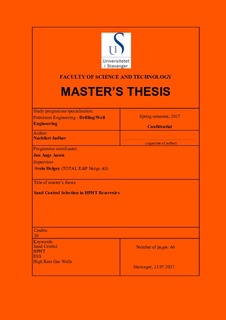| dc.contributor.advisor | Aasen, Jan Aage | |
| dc.contributor.author | Jadhav, Nachiket | |
| dc.date.accessioned | 2017-11-01T10:00:18Z | |
| dc.date.available | 2017-11-01T10:00:18Z | |
| dc.date.issued | 2017-07 | |
| dc.identifier.uri | http://hdl.handle.net/11250/2463379 | |
| dc.description | Master's thesis in Petroleum engineering | nb_NO |
| dc.description.abstract | High Pressure High Temperature (HPHT) reservoirs have shown to have great potential of oil and gas reserves through industrial experience. Norwegian Continental Shelf has such good potential HPHT reservoirs. But, HPHT reservoirs present their own challenges when drilling and completing wells in such reservoirs especially when they have the potential for Sand Production. It is necessary to design proper sand control mechanism to utilize the full potential of the reservoir. Lack of planning and information may lead to loss of production and unnecessary remedial work which will make the potential reservoir economically unviable.
This thesis presents the study of Sand Control Selection in HPHT High Rate Gas wells drilled in Total’s Martin Linge Field, main focus being on evaluation of use of ESS (Expandable Sand Screens). Martin Linge Field is the first field where ESS screens have been installed in HPHT reservoir and this study presents both theoretically and by the use of calculations if ESS is potentially a successful sand control strategy in HPHT fields, especially in HPHT high rate gas wells. Sand control completion design and production potential after the completion has been discussed extensively. Currently drilled gas wells completed with ESS in the field have known to show less potential for production than expected. The main objective here is to study the influence of different sand control methods on the productivity of wells by utilizing calculations and simulations and comparing those with the currently selected sand control completion by Total. Further, trying to identify the potential problems with current well completion and suggestion of alternative sand control completion procedure that might have been more productive. This study can then be used for future wells on Martin Linge and can also be useful in similar HPHT High Rate Gas wells.
The effect of influence of Sand Control Selection on the skin of the wellbore has been analyzed. Skin is known to directly show the influence of productivity on the wells. This analysis will help in selection and design of appropriate sand control selection in HPHT wells such that low skin can be obtained which will have a good effect on the productivity of the wells. Discussion has been done at the end of the report suggesting the viable sand control technique that can be successfully implemented in HPHT fields and future of ESS completion technique in HPHT fields. | nb_NO |
| dc.language.iso | eng | nb_NO |
| dc.publisher | University of Stavanger, Norway | nb_NO |
| dc.relation.ispartofseries | Masteroppgave/UIS-TN-IPT/2017; | |
| dc.rights | Attribution-NonCommercial-NoDerivatives 4.0 Internasjonal | * |
| dc.rights.uri | http://creativecommons.org/licenses/by-nc-nd/4.0/deed.no | * |
| dc.subject | petroleumsteknologi | nb_NO |
| dc.subject | petroleum engineering | nb_NO |
| dc.subject | ESS | nb_NO |
| dc.subject | HPHT | nb_NO |
| dc.subject | drilling | nb_NO |
| dc.subject | boreteknologi | nb_NO |
| dc.title | Sand Control Selection in HPHT Reservoirs | nb_NO |
| dc.type | Master thesis | nb_NO |
| dc.subject.nsi | VDP::Technology: 500::Rock and petroleum disciplines: 510::Petroleum engineering: 512 | nb_NO |

